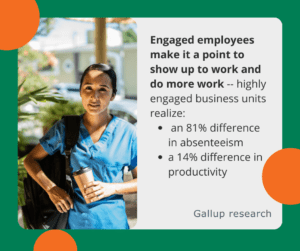Great organizational culture is cultivated by leaders who invest time and effort into enhancing it.
Research by Deloitte has shown that 94% of executives and 88% of employees believe a distinct corporate culture is important to a business’s success.
Consistently improving organizational culture demands an in-depth understanding of oneself, a keen alignment with the organization’s values and goals, and an even broader understanding of both prospective and current employees.
What is Organizational Culture?
Organizational culture refers to the shared behaviors, values, attitudes, and beliefs that define the way an organization operates. It encompasses the shared practices that shape the work environment, the interactions, and the decision-making processes within it.
Why Organizational Culture Is Important and What Employee Insights Can Do to Improve It
The culture within an organization influences how employees perceive and approach their work, ultimately shaping the company’s overall performance and success. According to a study done by Gallup, individuals who feel a strong connection to their organization’s culture are more likely to be engaged at work, recommend their workplace to others, and are less inclined to experience burnout or seek alternative employment.
This article will provide you with a step-by-step guide on how to use employee insights to effectively change and improve your organizational culture.
1. Understand the Current State of Your Organization’s Culture by Conducting Employee Engagement Surveys
Surveys and assessments are a great way to understand the current state of your organization’s culture. In particular, Employee Engagement Surveys are a quantitative and qualitative way to measure workforce sentiment to help understand what employees think about their place of work. They offer three key advantages:
-
They enable you to uncover how employees are feeling and their general attitudes toward the organization, as well as insight into the specific levers that underlie these feelings and attitudes.
-
They enable you to understand what is most important to the people in your organization.
-
They allow leaders to receive honest, anonymized feedback from employees about their experience at the organization.
Overall, their data provides a comprehensive snapshot of the existing culture, highlighting areas of strength and potential areas for improvement.
2. Analyze the Results, Share the Findings, and Identify Areas for Improvement
Employee Engagement Surveys pinpoint trends in feedback related to your organization’s procedures and practices, eliminating guesswork. For instance, if the survey results indicate low satisfaction with work location flexibility, but work location flexibility is also ranked low in importance, it is unlikely to contribute to negative perceptions of the organization. However, if the same survey reveals low satisfaction in this area but with a high-importance rating from employees, addressing this concern becomes a critical priority to prevent adverse effects on performance and morale.
eliminating guesswork. For instance, if the survey results indicate low satisfaction with work location flexibility, but work location flexibility is also ranked low in importance, it is unlikely to contribute to negative perceptions of the organization. However, if the same survey reveals low satisfaction in this area but with a high-importance rating from employees, addressing this concern becomes a critical priority to prevent adverse effects on performance and morale.
Leaders benefit from sharing the survey results and working with employees to identify areas of improvement.
TalentClick’s Attitude-Values-Personality Behavior Assessment helps leaders comprehend employees’ core workplace values. This understanding helps guide areas that need improvement and resource allocation, whether directed towards improving employee engagement through training and development, introducing benefits or incentives, or enhancing working conditions. Additionally, the assessment provides Participant Reports, promoting self-coaching and self-awareness, proven to foster development and engagement, ultimately contributing to an improved organizational culture.
3. Implement Changes to Your Organizational Culture With Measurable and Transparent Goals
With the necessary areas of improvement defined, the changes to improve the organizational culture must be both measurable and shared with employees for success. Decades of research show that you don’t need to convince everybody at once for change to take hold. Focus on selling the positive outcome that the change will bring. If the changes are designed to improve employee satisfaction, the majority of your workforce will be on board.
If the changes are clear, measurable, and attainable, all stakeholders can be involved in tracking the progress.
4. Monitor Progress and Communicate Updates Regularly
Change doesn’t happen overnight. To successfully implement changes for an improved organizational culture, establish a system of consistent progress monitoring and transparent communication. This involves setting up regular check-ins and updates with both employees and leadership and conducting annual Employee Engagement Surveys to monitor the success of the implemented changes. These check-ins and assessments serve as a platform to share insights, track advancements, and address any concerns or feedback.
By maintaining open lines of communication, everyone involved gains a clear understanding of the transformation process. It also fosters a sense of inclusivity, ensuring that employees feel heard and valued throughout the change. This ongoing dialogue not only holds the organization accountable for its goals but also empowers the workforce to participate in the shift toward a healthier work environment.
Employee Engagement Matters
Using employee insights is the key to sparking positive change in any organization. The steps outlined in this guide empower you to not only understand your workforce better but to also take meaningful action toward employee engagement and improved culture.
 Engaged employees make it a point to show up to work and do more work: organizations with highly engaged employees notice an 81% difference in absenteeism and a 14% difference in productivity. By using employee assessment solutions, you’re arming yourself with business intelligence, ultimately driving the creation of happier, safer, and more productive teams.
Engaged employees make it a point to show up to work and do more work: organizations with highly engaged employees notice an 81% difference in absenteeism and a 14% difference in productivity. By using employee assessment solutions, you’re arming yourself with business intelligence, ultimately driving the creation of happier, safer, and more productive teams.
Book a demo today to learn more about how TalentClick’s workforce technologies and employee engagement assessments can make your organization a better place to work.










